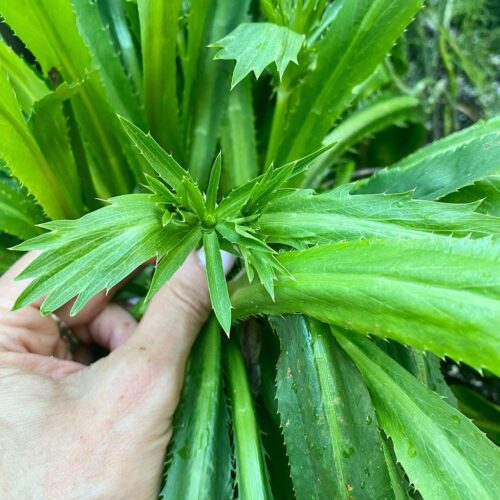Growing Culantro is not difficult; have this culinary herb in your garden for a strong flavor that doesn’t fade even after drying.
Culantro is a popular, fragrant herb that looks different from cilantro, but they both have similar leaf fragrances, though Culantro is stronger. It is grown as an annual, but it is biennial (grown for two years) in regions that are warm enough to allow this herb to overwinter. If you want to learn more about growing Culantro, read this post for details.
USDA Zone: 3-10
Common Names: Sawroot coriander, serrated coriander, recao, Nao Gai, Chardon benee, shado beni, fitweed, Maan Dhaniya (Assamese) coulante, long coriander, langer koriander (German), pak chi farang (Thai), and bhandhania.
What is Culantro?

Native to Mexico, Central, and South America, Culantro (Eryngium foetidum) is a green herb with long serrated leaves. It belongs to the Apiaceae family, which also includes celery, parsnip, and parsley. It grows like lettuce, with leaves around a central rosette. At maturity, the plant can grow up to 1 foot tall and have leaves 2 inches wide.
The leaves have both culinary and medicinal uses. They are used in cooking for their strong citrus flavor and pungent aroma, which mixes nicely under heat. This herb is widely used in Caribbean, Central American, and Vietnamese dishes.
What Does Culantro Taste Like?
Culantro has a pungent smell and bitter, soapy flavor like cilantro but stronger. It has a sweet, musty, cilantro-like or strong, burnt rubber-like aroma.
Planting Time
Plant Culantro indoors about eight weeks before the last frost date, and transplant the seedlings in containers or in the ground in an area with shade.
Propagating Culantro
Culantro can be grown from tiny seeds or cuttings, which is an easier option. Sow the seeds in the moist, sterilized seed starting mix. Speed up the germination by using a bottom heat—-transplant when the risk of frost is passed. The seeds will germinate in 14-28 days. Maintain a space of one plant per one-gallon pot or three plants per 5-gallon pot.
Container Size
Grow culantro in medium-sized coir pots or Cowpots. Keep in mind that it is a biennial plant with a central taproot and cannot be transplanted well.
Growing Culantro in the Garden
Growing culantro is similar to growing lettuce. Plant it after the last frost in spring and harvest individual leaves until the long days and high temperatures of summer arrive. During summer, culantro, like lettuce, will bolt, sending up a fast-growing stalk that will bloom and produce seeds. The plant typically dies soon after this process. If the seeds fall to the ground, the plant may reseed. However, in regions with winter frost, this tender tropical plant will not survive.
For optimal growth, plant culantro in the spring and remove the flower stalk as it appears to promote more leaf production instead of flowers. Eventually, the plant will flower, and when this happens, the leaves will become tougher and less desirable.
Ideal Growing Conditions for Culantro
Location
Culantro prefers full sun, but according to some growers, it will be more productive and form large, tender leaves for a longer period if planted in partial shade.
Do remember, if grown in full sun, Culantro will bloom early, which will shorten its lifespan compared to those planted in partial shade.
Soil
Use a rich, fertile, organic, well-drained soil with 6.0-7.5 pH.
Water
Check the moisture of the soil constantly, and water the plant when the top inch of the soil becomes dry.
Temperature
The required temperature for germination is 80 F (26 C).
Spacing
Space culantro 8-12 inches apart in an area with partial shade.
Culantro Care
Fertilizer
Boost leaf production by the regular use of liquid plant food or feed the plant bimonthly with a half-strength nitrogen-rich fertilizer. You can also side-dress them with aged manure or compost. Fish emulsion is also a good option.
Mulch
Apply mulch around plants to retain soil moisture and minimize soil splashing onto the leaves. Water regularly to maintain plant health.
Pruning
Prune the large outer foliage at the base and leave the young inside foliage to grow. It will promote bushier growth. Try to keep at least two-thirds of the plant intact.
Overwintering
Do not keep the plant outdoors if there are any chances of late frost. Protect the plants using black nursery pots turned upside down on the top of the plants; remove them in the morning when the temperature rises.
Pest and Disease
Mostly, culantro is pest and disease-free; it also attracts beneficial insects that protect against aphids.
Harvesting
To harvest fresh Culantro leaves for culinary use, cut the larger outer leaves individually. Cut the entire rosette at soil level with a knife for processing and preserving. To retain its flavor, chop the leaves in a food processor with enough olive oil to moisten. Transfer the mixture to a freezer container, add a layer of olive oil on top to prevent freezer burn, label the container, and freeze it. When you need culantro, simply chip off a piece with a knife.
Cooking with Culantro
Culantro has similar uses to cilantro, though the flavor of this herb is stronger. You can make a traditional use of it by making recaito, which is a Caribbean sauce used as a condiment in several cuisines.



